Related Research Articles
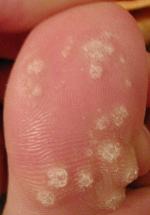
Warts are typically small, rough, hard growths that are similar in color to the rest of the skin. They typically do not result in other symptoms, except when on the bottom of the feet, where they may be painful. While they usually occur on the hands and feet, they can also affect other locations. One or many warts may appear. They are not cancerous.

A melanocytic nevus is a type of melanocytic tumor that contains nevus cells. Some sources equate the term mole with "melanocytic nevus", but there are also sources that equate the term mole with any nevus form.

Pubic hair is terminal body hair that is found in the genital area of adolescent and adult humans. The hair is located on and around the sex organs and sometimes at the top of the inside of the thighs. In the pubic region around the pubis bone, it is known as a pubic patch. Pubic hair is also found on the scrotum in the male and on the vulva in the female.
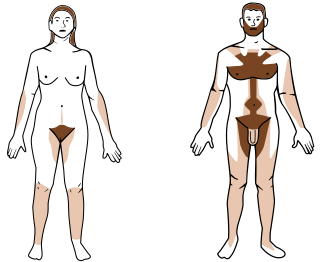
Hair removal, also known as epilation or depilation, is the deliberate removal of body hair or head hair.

Genital warts are a sexually transmitted infection caused by certain types of human papillomavirus (HPV). They are generally pink in color and project out from the surface of the skin. Usually they cause few symptoms, but can occasionally be painful. Typically they appear one to eight months following exposure. Warts are the most easily recognized symptom of genital HPV infection.

Bufo is a genus of true toads in the amphibian family Bufonidae. As traditionally defined, it was a wastebasket genus containing a large number of toads from much of the world, but following taxonomic reviews most of these have been moved to other genera, leaving only seventeen extant (living) species from Europe, northern Africa and Asia in this genus, including the well-known common toad. Some of the genera that contain species formerly placed in Bufo are Anaxyrus, Bufotes, Duttaphrynus, Epidalea and Rhinella.

Waxing is the process of hair removal from the root by using a covering of a sticky substance, such as wax, to adhere to body hair, and then removing this covering and pulling out the hair from the follicle. New hair will not grow back in the previously waxed area for four to six weeks, although some people will start to see regrowth in only a week due to some of their hair being on a different human hair growth cycle. Almost any area of the body can be waxed, including eyebrows, face, pubic hair, legs, arms, back, abdomen, knuckles, and feet. There are many types of waxing suitable for removing unwanted hair.

A plantar wart, or verruca, is a wart occurring on the bottom of the foot or toes. Its color is typically similar to that of the skin. Small black dots often occur on the surface. One or more may occur in an area. They may result in pain with pressure such that walking is difficult.

Et Cetera, abbreviated to etc., etc, et cet., &c. or &c is a Latin expression that is used in English to mean "and other similar things", or "and so forth". Translated literally from Latin, et means 'and', while cētera means 'the rest'; thus the expression translates to 'and the rest '.
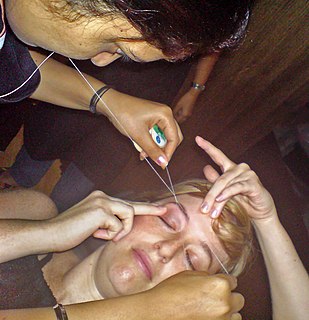
Threading is a method of hair removal originating in India or Central Asia. In more recent times it has gained popularity in Western countries, especially with a cosmetic application.
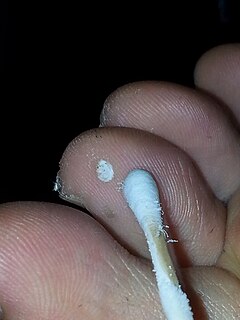
Cryosurgery is the use of extreme cold in surgery to destroy abnormal or diseased tissue; thus, it is the surgical application of cryoablation. The term comes from the Greek words cryo (κρύο) and surgery meaning "hand work" or "handiwork". Cryosurgery has been historically used to treat a number of diseases and disorders, especially a variety of benign and malignant skin conditions.

A milium, also called a milk spot or an oil seed, is a clog of the eccrine sweat gland. It is a keratin-filled cyst that can appear just under the epidermis or on the roof of the mouth. Milia are commonly associated with newborn babies, but can appear on people of all ages. They are usually found around the nose and eyes, and sometimes on the genitalia, often mistaken by those affected as warts or other sexually transmitted diseases. Milia can also be confused with stubborn whiteheads.
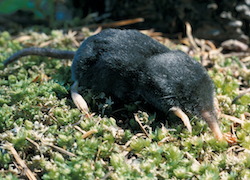
The American shrew mole is the smallest species of mole. It is the only living member of the genus Neurotrichus and the tribe Neurotrichini. It is also known as Gibb's shrew mole and least shrew mole. It is not closely related to the Asian shrew mole. The reason that it is called a "shrew mole" instead of being called either a "shrew" or a "mole" is because of its fur, which is a characteristic of shrews and its large head and heavy dentition, which is characteristic of moles.

A dysplastic nevus or atypical mole is a nevus (mole) whose appearance is different from that of common moles. In 1992, the NIH recommended that the term "dysplastic nevus" be avoided in favor of the term "atypical mole". An atypical mole may also be referred to as an atypical melanocytic nevus, atypical nevus, B-K mole, Clark's nevus, dysplastic melanocytic nevus, or nevus with architectural disorder.

Hair care is an overall term for hygiene and cosmetology involving the hair which grows from the human scalp, and to a lesser extent facial, pubic and other body hair. Hair care routines differ according to an individual's culture and the physical characteristics of one's hair. Hair may be colored, trimmed, shaved, plucked or otherwise removed with treatments such as waxing, sugaring and threading. Hair care services are offered in salons, barbershops and day spas, and products are available commercially for home use. Laser hair removal and electrolysis are also available, though these are provided by licensed professionals in medical offices or speciality spas.

An epilator is an electrical device used to remove hair by mechanically grasping multiple hairs simultaneously and pulling them out. The way in which epilators pull out hair is similar to waxing, although unlike waxing, they do not remove cells from the epithelium of the epidermis. Aside from the spring in early spring-type epilators, there are no parts in epilators that require regular replacement. Epilators come in corded, rechargeable and battery-operated designs. The battery-operated devices can be used wet or dry. They may also come with various attachments, like a smaller head to help with epilation of hard-to-reach areas, or an exfoliation head that may help exfoliate the skin before and after epilation.

The Cape mole-rat is a species of mole-rat endemic to South Africa. It is the only extant species currently described as belonging in the genus Georychus.
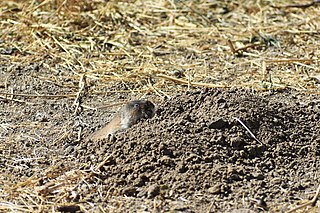
The Zaisan mole vole, or eastern mole vole, is a species of rodent in the family Cricetidae. It is found in central Asia.

Sinéad Mulvey is an Irish professional singer & air hostess who, alongside Black Daisy, represented her country at the Eurovision Song Contest 2009 with the pop-rock song "Et Cetera". The song was performed in the second semi-final but missed out on qualification to the grand final.

The Vietnamese mole is a species of talpine mole found in Vietnam.